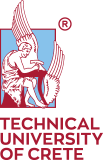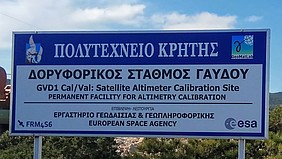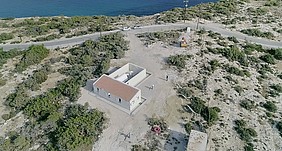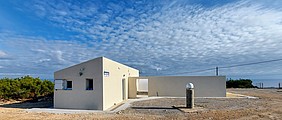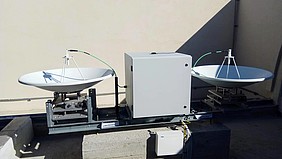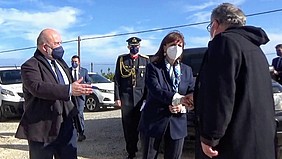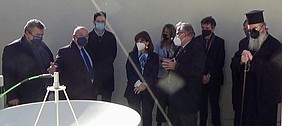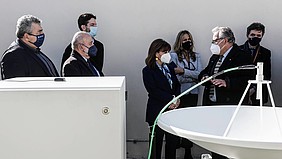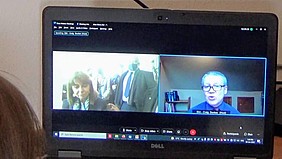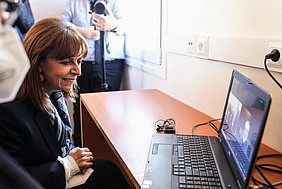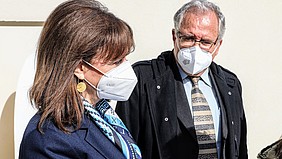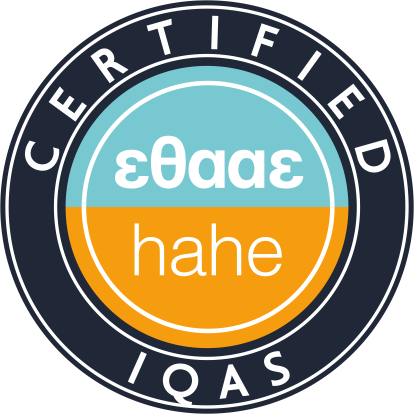The President of the Hellenic Republic (PHR), Mrs. Katerina Sakellaropoulou, visited the Gavdos Satellite Station of the Technical University of Crete on Thursday, January 6, 2022 as part of her official visit to the island of Gavdos to celebrate the Epiphany.
The PHR was welcomed and guided by the Rector of the Technical University of Crete, Prof. Evan Diamadopoulos, as well as the Scientific Officer of the station, Mr. Stelios Mertikas, Professor of the School of Mineral Resources Engineering and Director of the Laboratory of Geodesy and Geography. Also, present on behalf of the Technical University of Crete were the Vice Rectors, Assoc. Prof. Michail G. Lagoudakis and Prof. Nikolaos Kallithrakas-Kontos, as well as the PhD candidate Konstantinos Kokolakis, member of the Scientific Team of the Laboratory of Geodesy and Geography.
The Chronicle of the Visit
The PHR traveled from Chora Sfakion to Gavdos by ferry boat with all the authorities and officials who accompanied her, after first arriving by air to Chania and by road to Sfakia. The members of the Rectorate of the Technical University of Crete also traveled with her, while the members of the Scientific Team of the Satellite Station were already in Gavdos from the previous day to prepare the visit. After the two-hour (and stormy) trip and the arrival in Gavdos, the Great Sanctification of the Epiphany was performed in the port of Karave and then in the City Hall of Gavdos the PHR was declared an honorary citizen of the island of Gavdos. These events were followed by visits to the interesting and historical sites of the island, including the Gavdos Satellite Station of the Technical University of Crete.
The PHR arrived at the station at around 13:30, accompanied by her partner Mr. Pavlos Kotsonis, the Mayor of Gavdos Mrs. Lillian Stefanakis, the Deputy Regional Governor of Chania Mr. Nikos Kalogeris, the Bishop of Kissamos and Selinos Rev. Amphilochios, as well as political and military authorities.
The PHR was guided by the Rector and Prof. Mertikas to the new facilities of the station, which were delivered in the autumn of 2021. Prof. Mertikas stressed that this is a project of national, strategic and scientific importance, as at this geographical point above Gavdos the orbits of many operational and scientific satellites intersect and the station functions as another satellite on earth that communicates with the passers-by satellites to allow them to be calibrated and eliminate the accumulated errors in each passage over the island of Gavdos. He explained that this is the only facility with this level of specialized transponder equipment (there are only three in the world), which now functions as the permanent facility of the European Space Agency (ESA) to calibrate all its satellites that monitor climate change. The PHR was impressed by the fact that the altitude calibration (altimetry) is done with an accuracy of one centimeter, although the distance between the satellite in orbit and the ground station is about 1300 kilometers!
The PHR then spoke via teleconference with Dr. Craig Donlon from the European Space Research and Technology Center (ESTEC) of the European Space Agency (ESA) in the Netherlands, who is the Head of Scientific Earth Observation Missions. Dr. Donlon praised the importance of the station in the special geographical position of Gavdos and the contribution of the Technical University of Crete to the necessary periodic calibration of satellites that monitor climate change and carry out measurements all year round, every day, around the clock. The PHR said she was very impressed by what she saw on the Gavdos Satellite Station and Dr. Donlon thanked her on behalf of ESA for her interest to include the station in her timetable.
The PHR left the station, congratulating the TUC Rector and Prof. Mertikas for this scientific achievement of the Technical University of Crete, which brings space to the remote island of Gavdos.
With the completion of the visits to the points of interest in the island, the members of the Technical University of Crete again had the opportunity to talk and be photographed with the PHR, during the lunch that was offered, at the port before departure, but also at sea during the return by boat to Chora Sfakion.
[Click here to browse the photo album of the visit of the PHR]
(Photos: Th. Manolopoulos, M. Lagoudakis, St. Mertikas, N. Kallitrhrakas)
The Gavdos Satellite Station
After two years of work and in the midst of a pandemic, the permanent facilities of the European Space Agency (ESA) in the island of Gavdos at a property owned by the Technical University of Crete were completed in the autumn of 2021. These installations control how the instruments carried by altimetry satellites operate, behave and evolve over time, as well as what the reliability and accuracy of their measurements and results are. Altimetry satellites observe from 1300 km high the change of sea level, wave height and wind speed and essentially climate change, in an objective and indisputable way, thanks to the facilities in Gavdos, in relation to the center of mass of the Earth and with accuracy of ±1 cm.
Satellite observations are controlled by scientific equipment (microwave transponder) developed and built by the Technical University of Crete and the European Space Agency. These two instruments are unique in the world and are located in the mountains of Western Crete and Gavdos. Similar ground equipment is being prepared by NASA in the island of Catalina (similar to Gavdos), off the coast of Southern California in the USA.
In early October 2021, the director of all ESA Earth Observation Missions, Dr. Craig Donlon, visited the Technical University of Crete for a week. He inspected the new facilities of the European Space Agency in Gavdos, had meetings with the TUC Rector and the Laboratory of Geodesy and Geoinformatics, and attended the first measurement that took place on October 11, 2021 in Gavdos at 16:33:42 in the afternoon with the Sentinel-6A and Jason-3 satellites. From December 18, 2020 to March 2022, the Sentinel-6A and Jason-3 satellites fly one behind the other, on the exact same orbit and at a distance of 200km. Thus, the measurements and behavior of the new Sentinel-6A satellite are analyzed and evaluated by the Gavdos station in relation to the leading by 200 km Jason-3 satellite.
The measurements and the results of these two satellites from the ESA ground facilities in Gavdos are further analyzed and evaluated by a group of 15 people with representatives of the Technical University of Crete, the European Space Agency, the European Eumesat Center in Germany, the French Space Agency, NASA, of the US Oceanic and Atmospheric Center (NOAA), and ESA partners from France, Spain, Italy and Germany. Scientific Head of the station is Prof. Stelios P. Mertikas of the School of Mineral Resources Engineering at the Technical University of Crete.
Publicity
The visit of the PHR to the island of Gavdos and to the Satellite Station of the Technical University of Crete was quite popular in the electronic media, as evidenced in the following links.
- Προεδρία της Δημοκρατίας (presidency.gr)
- Δήμος Γαύδου (gavdos.gr)
- Καθημερινή (kathimerini.gr)
- ΕΡΤ (ertnews.gr)
- Νέα Κρήτη (neakriti.gr)
- Flash News (flashnews.gr)
- Creta Post (cretapost.gr)
- Εφημερίδα των Συντακτών (efsyn.gr)
- Ορθοδοξία News Agency (orthodoxianewsagency.gr)
- Athens Voice (athensvoice.gr)
- Κρήτη 360 (kriti360.gr)
- Κρήτη TV (youtube.com)
- Νέα Τηλεόραση Κρήτης (youtube.com)
- Kathimerini (ekathimerini.com)
- New Fox 24 (new.fox-24.com)
- News Bulletin 24/7 (newsbulletin247.com)
- Εφημερίδα των Συντακτών (efsyn.gr)
- Flash News (flashnews.gr)
- Prisma News (prismanews.gr)
- Κρήτη 24 (kriti24.gr)
- Creta Live (cretalive.gr)
- Politica (politica.gr)
- Παρακρητικά (parakritika.gr)
- Πολυτεχνικά Νέα (polytechnikanea.gr)





